Influence of Grain Boundary Precipitates on Intergranular Corrosion Behavior of 7050 Al Alloys
Abstract
:1. Introduction
2. Material and Experimental Procedure
3. Results and Discussion
3.1. Corrosion Morphology
3.2. Grain Boundary Precipitates Feature
3.3. Influence Mechanism on Intergranular Corrosion of GBPs
4. Conclusions
Author Contributions
Funding
Institutional Review Board Statement
Informed Consent Statement
Data Availability Statement
Conflicts of Interest
References
- Williams, J.C.; Starke, E.A. Progress in structural materials for aerospace systems. Acta Mater. 2003, 51, 5775–5799. [Google Scholar] [CrossRef]
- Xiao, Q.F.; Huan, J.W.; Jiang, Y.G.; Jiang, F.Q.; Wu, Y.F.; Xu, G.F. Effects of minor Sc and Zr additions on mechanical properties and microstructure evolution of Al-Zn-Mg-Cu alloys. Trans. Nonferrous Met. Soc. China 2020, 30, 1429–1438. [Google Scholar] [CrossRef]
- Chen, J.F.; Zou, L.C.; Yu, Y.; Li, Q.; Chen, Y.L. Microstructure evolution of 7050 Al alloy during age-forming. Mater. Charact. 2015, 102, 114–121. [Google Scholar] [CrossRef]
- Özer, G.; Karaaslan, A. Relationship of RRA heat treatment with exfoliation corrosion, electrical conductivity and microstructure of AA7075 alloy. Mater. Corros. 2017, 68, 1260–1267. [Google Scholar] [CrossRef]
- Fang, H.C.; Chao, H.; Chen, K.H. Effect of recrystallization on intergranular fracture and corrosion of Al-Zn-Mg-Cu-Zr alloy. J. Alloys Compd. 2015, 622, 166–173. [Google Scholar] [CrossRef]
- Chubb, J.P.; Morad, T.A.; Hockenhull, B.S. The effect of exfoliation corrosion on the fracture and fatigue behaviour of 7178-T6 aluminium. Int. J. Fatigue 1995, 17, 49–54. [Google Scholar] [CrossRef]
- Lin, Y.C.; Zhang, J.L.; Liu, G.; Liang, Y.J. Effects of pre-treatments on aging precipitates and corrosion resistance of a creep-aged Al-Zn-Mg-Cu alloy. Mater. Des. 2015, 83, 866–875. [Google Scholar] [CrossRef]
- Wang, B.J.; Xu, K.; Xu, D.K.; Cai, X.; Qiao, Y.X.; Sheng, L.Y. Anisotropic corrosion behavior of hot-rolled Mg-8 wt.%Li alloy. J. Mater. Sci. Technol. 2020, 53, 102–111. [Google Scholar] [CrossRef]
- Wang, B.J.; Xu, D.K.; Sun, J.; Han, E.H. Effect of grain structure on the stress corrosion cracking (SCC) behavior of an as-extruded Mg-Zn-Zr alloy. Corros. Sci. 2019, 157, 347–356. [Google Scholar] [CrossRef]
- Marlaud, T.; Malki, B.; Henon, C.; Deschamps, A.; Baroux, B. Relationship between alloy composition, microstructure and exfoliation corrosion in Al-Zn-Mg-Cu alloys. Corros. Sci. 2011, 53, 3139–3149. [Google Scholar] [CrossRef]
- Wang, G.; Wu, Y.; Kou, L.Y.; Zhang, P.; Zou, Z.K.; Zhu, X.J. Effect of corrosion on mechanical properties of 2024 aluminum alloy. Chin. J. Nonferrous Met. 2021, 31, 10–22. [Google Scholar] [CrossRef]
- Chen, J.F.; Zhan, X.F.; Zou, L.C.; Yu, Y.; Li, Q. Effect of precipitate state on the stress corrosion behavior of 7050 aluminum alloy. Mater. Charact. 2016, 114, 1–8. [Google Scholar] [CrossRef]
- Liang, W.J.; Pan, Q.L.; He, Y.B.; Li, Y.C.; Zhou, Y.C.; Lu, C.G. Effect of aging on the mechanical properties and corrosion susceptibility of an Al-Cu-Li-Zr alloy containing Sc. Rare Met. 2008, 27, 146–152. [Google Scholar] [CrossRef]
- Lu, X.; Han, X.; Du, Z.; Wang, G.; Lu, L.; Lei, J.; Zhou, T. Effect of microstructure on exfoliation corrosion resistance in an Al-Zn-Mg alloy. Mater. Charact. 2018, 135, 167–174. [Google Scholar] [CrossRef]
- Ralston, K.D.; Birbilis, N.; Weyland, M.; Hutchinson, C.R. The effect of precipitate size on the yield strength-pitting corrosion correlation in Al-Cu-Mg alloys. Acta Mater. 2010, 58, 5941–5948. [Google Scholar] [CrossRef]
- Knight, S.P.; Birbilis, N.; Muddle, B.C.; Trueman, A.R.; Lynch, S.P. Correlations between intergranular stress corrosion cracking, grain-boundary microchemistry and grain-boundary electrochemistry for Al-Zn-Mg-Cu alloys. Corros. Sci. 2010, 52, 4073–4080. [Google Scholar] [CrossRef]
- Wang, S.S.; Huang, W.; Yang, L.; Jiang, J.T.; Chen, J.F.; Dai, S.L.; Seidman, D.N.; Frankel, G.S.; Zhen, L. Effect of Cu content and aging conditions on pitting corrosion damage of 7xxx series aluminum alloys. J. Electrochem. Soc. 2015, 162, 150–160. [Google Scholar] [CrossRef]
- Wang, F.; Xiong, B.; Zhang, Y.; Zhu, B.; Liu, H.; He, X. Effect of heat treatment on the microstructure and mechanical properties of the spray-deposited Al-10.8Zn-2.8Mg-1.9Cu alloy. Mater. Sci. Eng. A. 2008, 486, 648–652. [Google Scholar] [CrossRef]
- Chen, L.; Pan, Q.; Shi, Y.; Wang, Y.; Li, B. Influence of aging temperature on corrosion behavior of Al-Zn-Mg-Sc-Zr alloy. Mater. Des. 2014, 55, 551–559. [Google Scholar]
- Jiang, J.T.; Tang, Q.J.; Yang, L.; Zhen, L. Non-isothermal ageing of an Al-8Zn-2Mg-2Cu alloy for enhanced properties. J. Mater. Process. Technol. 2016, 227, 110–116. [Google Scholar] [CrossRef]
- Li, Y.; Xu, G.F.; Peng, X.Y.; Liu, S.C.; Deng, Y.; Liang, X.P. Effect of non-isothermal aging on microstructure and properties of Al-5.87Zn-2.07Mg-2.42Cu alloys. Trans. Nonferrous Met. Soc. China 2021, 31, 2899–2908. [Google Scholar] [CrossRef]
- Xie, L.; Lei, Q.; Wang, M.; Sheng, X. Effects of aging mechanisms on the exfoliation corrosion behavior of a spray deposited Al-Zn-Mg-Cu-Zr aluminum alloy. J. Mater. Res. 2017, 32, 1105–1117. [Google Scholar] [CrossRef]
- Chen, J.F.; Zhen, L.; Jiang, J.T.; Yang, L.; Shao, W.Z.; Zhang, B.Y. Microstructures and mechanical properties of age-formed 7050 aluminum alloy. Mater. Sci. Eng. A 2012, 539, 115–123. [Google Scholar] [CrossRef]
- Ikeuba, A.I.; Zhang, B.; Wang, J.; Han, E.H.; Ke, W.; Okafor, P.C. SVET and SIET study of galvanic corrosion of Al/MgZn2 in aqueous solutions at different pH. J. Electrochem. Soc. 2018, 165, C180–C194. [Google Scholar] [CrossRef]
- Wang, Z.; Jiang, H.; Li, H. Effect of solution-treating temperature on the intergranular corrosion of a peak-aged Al-Zn-Mg-Cu alloy. J. Mater. Sci. Technol. 2020, 9, 6497–6511. [Google Scholar] [CrossRef]
- Charitidou, E.; PapapolAYmerou, G.; Haidemenopoulos, G.N.; Hasiotis, N.; Bontozoglou, V. Characterization of trapped hydrogen in exfoliation corroded aluminum alloy 2024. Scr. Mater. 1999, 41, 1327–1332. [Google Scholar] [CrossRef] [Green Version]
- Huang, L.P.; Chen, K.H.; Li, S.; Song, M. Influence of high-temperature pre-precipitation on local corrosion behaviors of Al-Zn-Mg alloy. Scr. Mater. 2007, 56, 305–308. [Google Scholar] [CrossRef]
- ASTM G34-01; Standard Test Method for Exfoliation Corrosion Susceptibility in 2xxx and 7xxx Series Aluminum Alloys (EXCO Test). ASTM International: West Conshohocken, PA, USA, 2013.
- Chen, J.F.; Frankel, G.S.; Jiang, J.T.; Shao, W.Z.; Zhen, L. Effect of age-forming on corrosion properties of an Al-Zn-Mg-Cu alloy. Mater. Corros. 2014, 65, 670–677. [Google Scholar] [CrossRef]
- Song, F.X.; Zhang, X.M.; Liu, S.D.; Tan, Q.; Li, D.F. The effect of quench rate and overageing temper on the corrosion behaviour of AA7050. Corros. Sci. 2014, 78, 276–286. [Google Scholar] [CrossRef]
- Song, F.X.; Zhang, X.M.; Liu, S.D.; Tan, Q.; Li, D.F. Exfoliation corrosion behavior of 7050-T6 aluminum alloy treated with various quench transfer time. Trans. Nonferrous Met. Soc. China 2014, 24, 2258–2265. [Google Scholar] [CrossRef]
- Birbilis, N.; Buchheit, R.G. Investigation and discussion of characteristics for intermetallic phases common to aluminum alloys as a function of solution pH. J. Electrochem. Soc. 2008, 155, 117–126. [Google Scholar] [CrossRef] [Green Version]
- Leblanc, P.; Frankel, G.S. A Study of Corrosion and Pitting Initiation of AA2024-T3 Using Atomic Force Microscopy. J. Electrochem. Soc. 2002, 149, 239–247. [Google Scholar] [CrossRef]
- Birbilis, N.; Buchheit, R.G. Electrochemical characteristics of intermetallic phases in aluminum alloys. J. Electrochem. Soc. 2005, 152, 140–151. [Google Scholar] [CrossRef] [Green Version]
- Meng, Q.; Frankel, G.S. Effect of Cu content on corrosion behavior of 7xxx series aluminum alloys. J. Electrochem. Soc. 2004, 151, B271–B283. [Google Scholar] [CrossRef]
- Maitra, S.; English, G. Environmental factors affecting localized corrosion of 7075-T7351 aluminum alloy plate. Metall. Trans. A 1982, 13, 161–166. [Google Scholar]
- Marlaud, T.; Deschamps, A.; Bley, F.; Lefebvre, W.; Baroux, B. Influence of alloy composition and heat treatment on precipitate composition in Al–Zn–Mg–Cu alloys. Acta Mater. 2010, 58, 248–260. [Google Scholar] [CrossRef]
- Kannan, M.B.; Raja, V. Influence of heat treatment and scandium addition on the electrochemical polarization behavior of Al–Zn–Mg–Cu–Zr alloy. Metall. Trans. A. 2007, 38, 2843–2852. [Google Scholar] [CrossRef]
- Ramgopal, T.; Schmutz, P.; Frankel, G.S. Electrochemical behavior of thin film analogs of Mg(Zn, Cu, Al)2. J. Electrochem. Soc. 2001, 148, B348–B356. [Google Scholar] [CrossRef] [Green Version]
- Chen, S.Y.; Chen, K.H.; Peng, G.S.; Jia, L.; Dong, P.X. Effect of heat treatment on strength, exfoliation corrosion and electrochemical behavior of 7085 aluminum alloy. Mater. Des. 2012, 35, 93–98. [Google Scholar] [CrossRef]
- Li, J.F.; Zheng, Z.Q.; Jiang, N.; Tan, C.Y. Localized corrosion mechanism of 2×××−series Al alloy containing S(Al2CuMg) and θ’(Al2Cu) precipitates in 4.0% NaCl solution at pH 6.1. Mater. Chem. Phys. 2005, 91, 325–329. [Google Scholar] [CrossRef]
- Ali, N.B.; Tanguy, D.; Estevez, R. Effects of microstructure on hydrogen-induced cracking in aluminum alloys. Scr. Mater. 2011, 65, 210–213. [Google Scholar] [CrossRef]
- Song, R.G.; Dietzel, W.; Zhang, B.J.; Liu, W.J.; Tseng, M.K.; Atrens, A. Stress corrosion cracking and hydrogen embrittlement of an Al-Zn-Mg-Cu alloy. Acta Mater. 2004, 52, 4727–4743. [Google Scholar] [CrossRef]
- Zhang, Z.; Deng, Y.; Ye, L. Influence of aging treatments on the strength and localized corrosion resistance of aged Al–Zn–Mg–Cu alloy. J. Alloys Compd. 2020, 846, 156223. [Google Scholar] [CrossRef]
- Christodoulou, L.; Flower, H.M. Hydrogen embrittlement and trapping in Al-Zn-Mg alloys. Acta Metall. 1980, 28, 481–487. [Google Scholar] [CrossRef]
- Shi, Y.J.; Pan, Q.L.; Li, M.J.; Huang, X.; Li, B. Effect of Sc and Zr additions on corrosion behaviour of Al-Zn-Mg-Cu alloys. J. Alloys Compd. 2014, 612, 42–50. [Google Scholar] [CrossRef]
- Ramgopal, T.; Gouma, P.I.; Frankel, G.S. Role of grain-boundary precipitates and solute-depleted zone on the intergranular corrosion of aluminum alloy 7150. Corrosion 2002, 58, 687–697. [Google Scholar] [CrossRef]
- Zeng, F.L.; Wei, Z.L.; Li, J.F.; Li, C.X.; Tan, X.; Zhang, Z.; Zheng, Z.Q. Corrosion mechanism associated with Mg2Si and Si particles in Al-Mg-Si alloys. Trans. Nonferrous Met. Soc. China 2011, 21, 2559–2567. [Google Scholar] [CrossRef]
- Li, B.; Pan, Q.L.; Chen, C.P.; Yin, Z.M. Effect of aging time on precipitation behavior, mechanical and corrosion properties of a novel Al-Zn-Mg-Sc-Zr alloy. Trans. Nonferrous Met. Soc. China 2016, 26, 2263–2275. [Google Scholar] [CrossRef]
- Li, H.; Zhao, P.P.; Wang, Z.X. The intergranular corrosion susceptibility of a heavily overaged Al-Mg-Si-Cu alloy. Corros. Sci. 2016, 107, 113–122. [Google Scholar] [CrossRef]
- Brunner, J.G.; Birbilis, N.; Ralston, K.D. Impact of ultrafinegrained microstructure on the corrosion of aluminium alloy AA2024. Corros. Sci. 2012, 57, 209–214. [Google Scholar] [CrossRef]



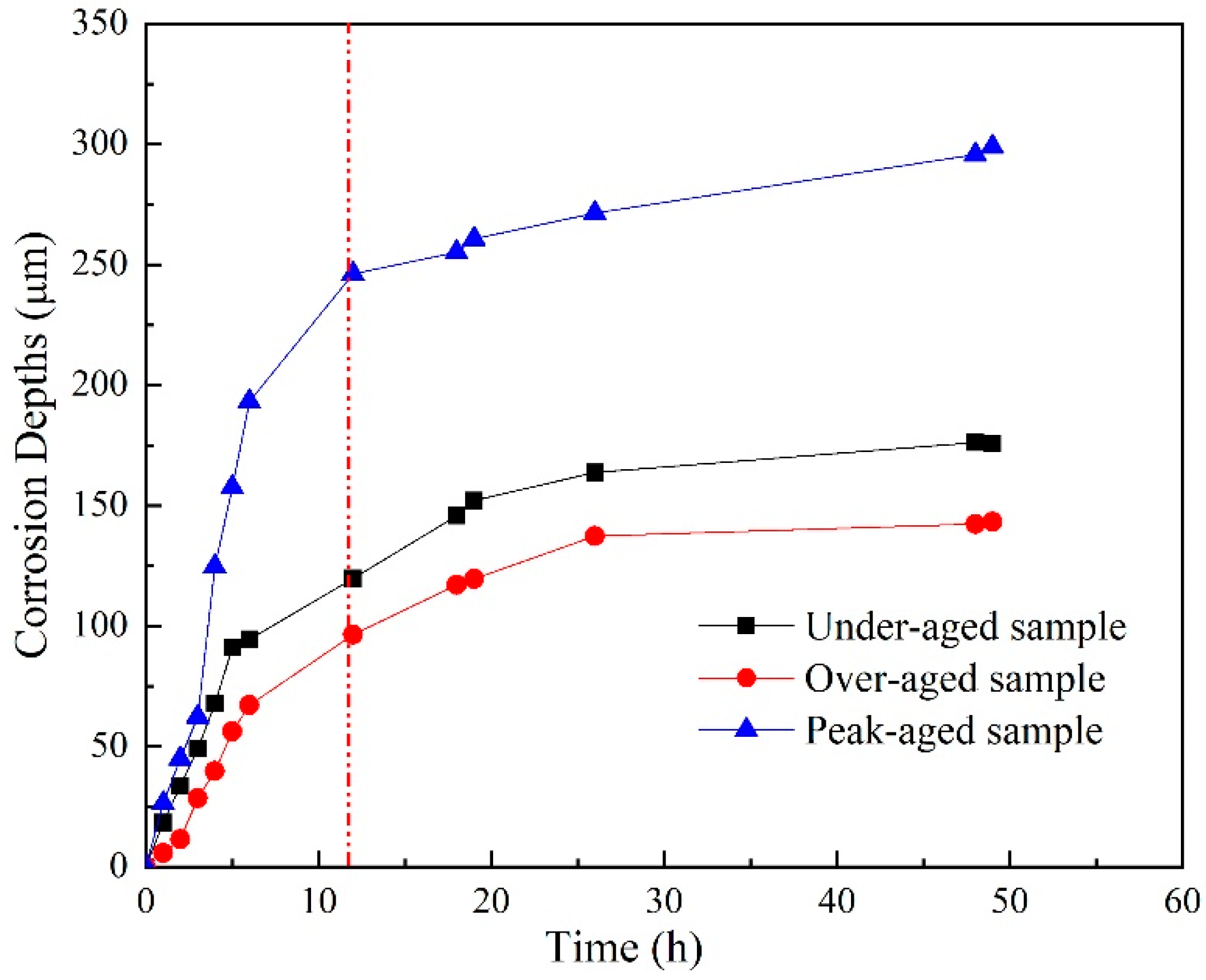
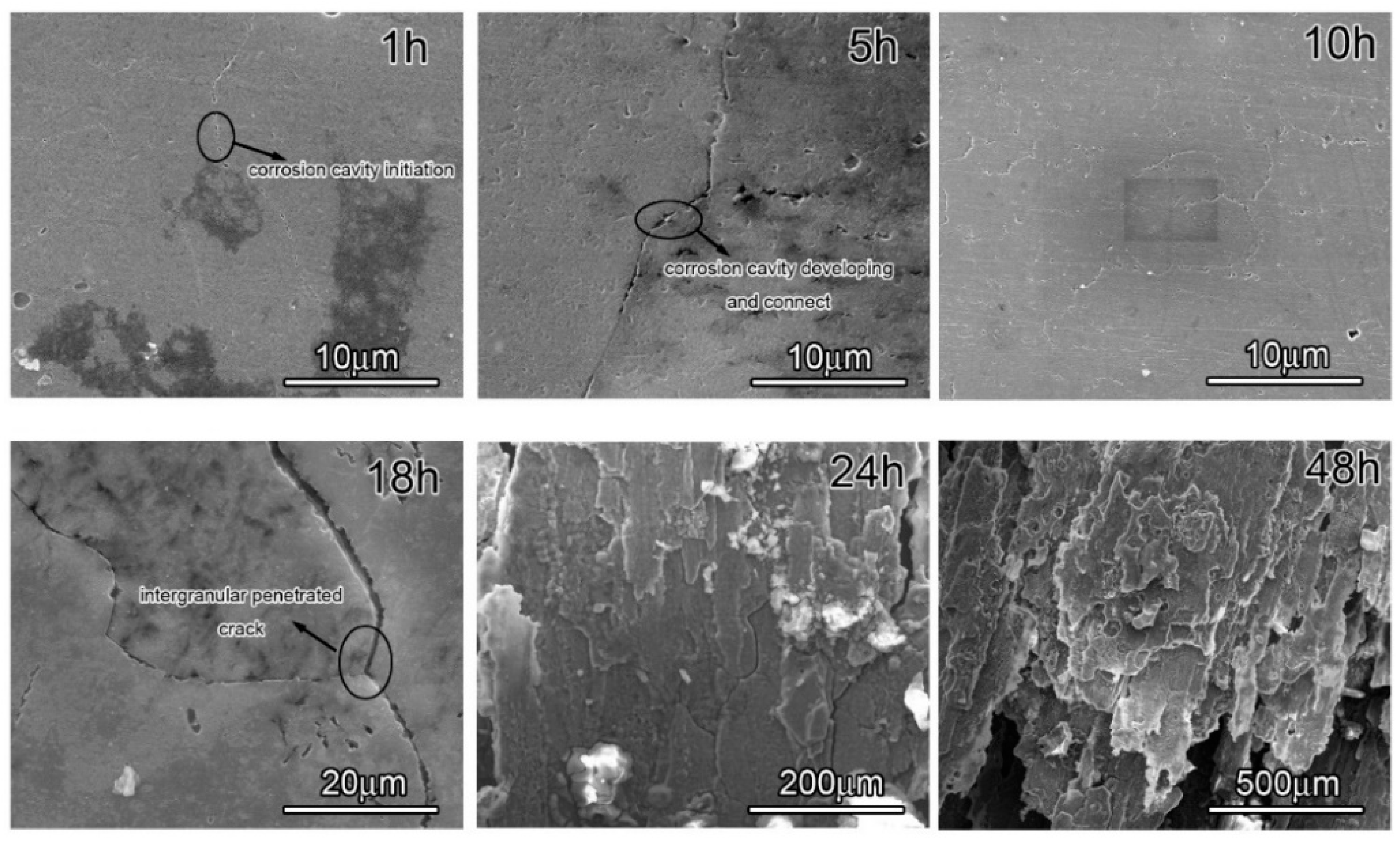
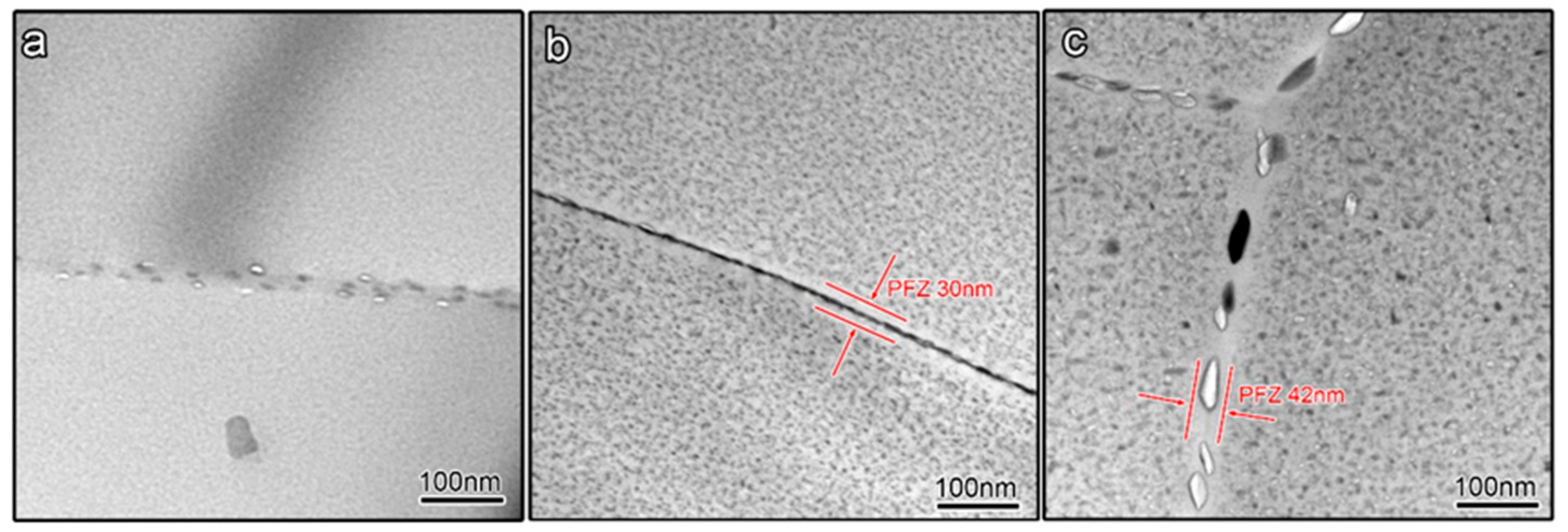
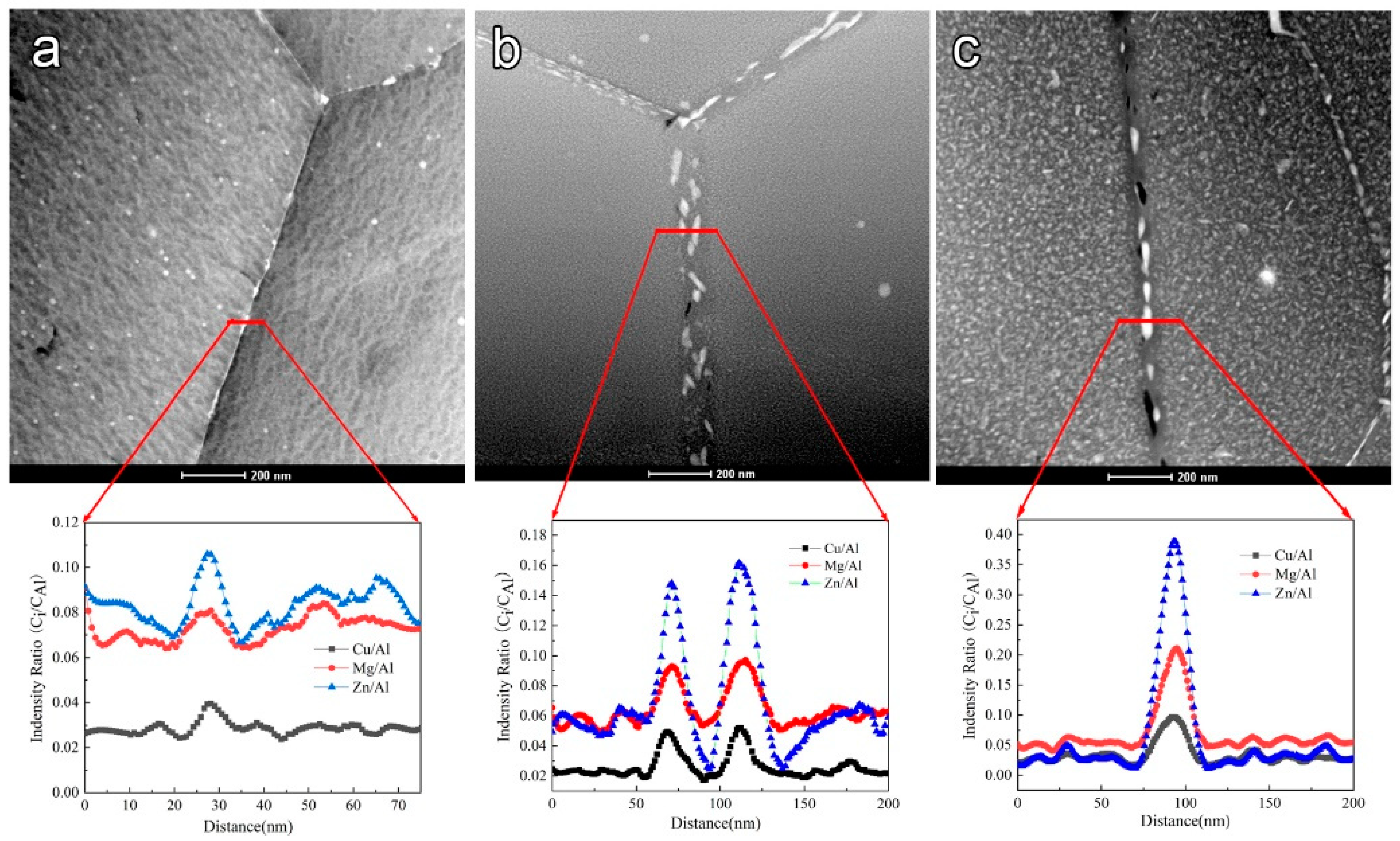
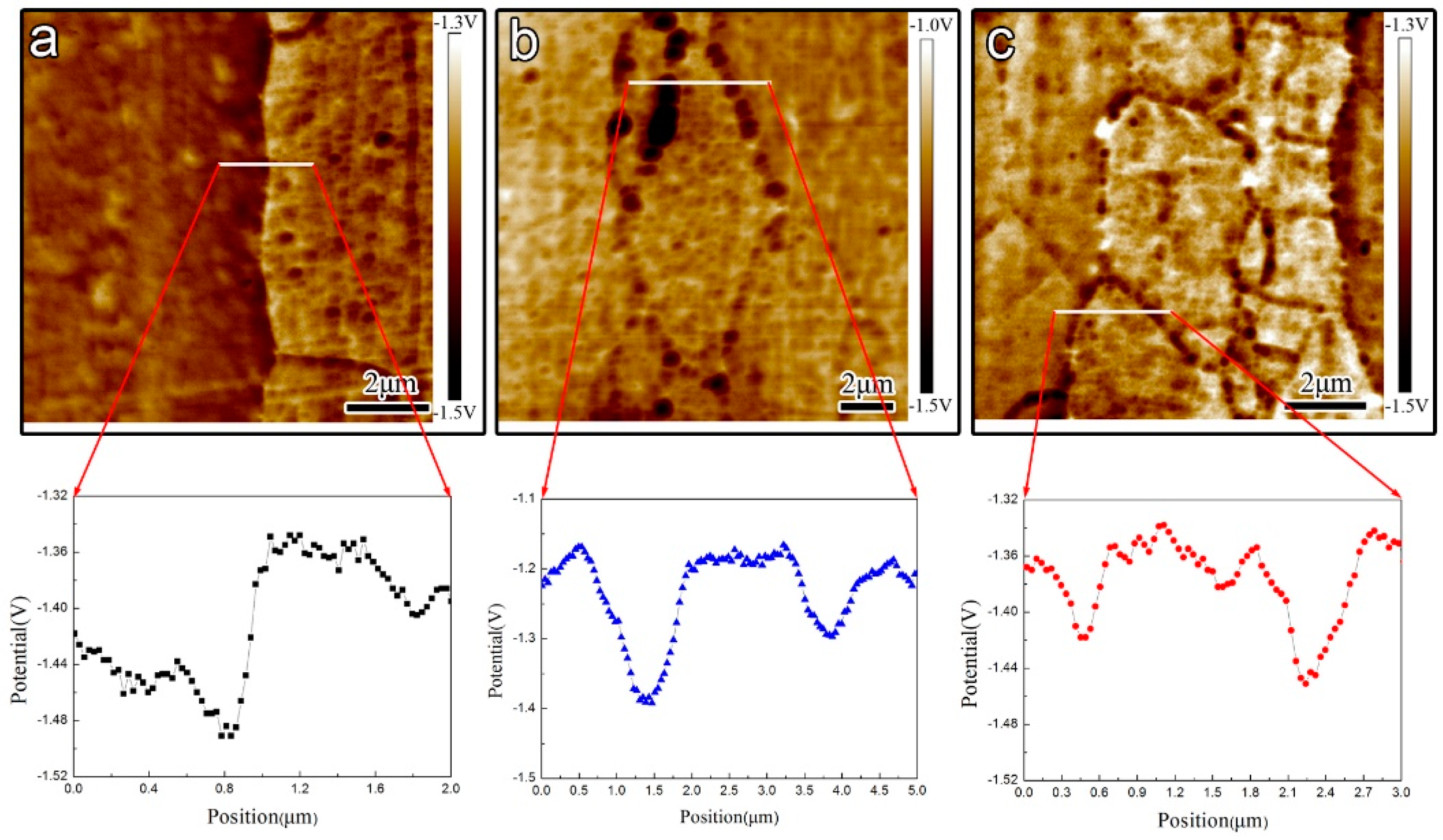
| Samples | Heat-Treatment Methods | HV0.2 |
|---|---|---|
| UA | 475 °C/2 h water quench + 120 °C/12 h | 140 |
| PA | 475 °C/2 h water quench + 120 °C/24 h | 190 |
| OA | 475 °C/2 h water quench + 160 °C/30 h | 160 |
| Samples | GBP Size (nm) | Space between GBPs (nm) | PFZ Width (nm) |
|---|---|---|---|
| UA | 10 ± 3 | 0 | 0 |
| PA | 30 ± 8 | 7 ± 3 | 30 ± 5 |
| OA | 60 ± 10 | 30 ± 10 | 42 ± 10 |
| Temper | Cu/Al | Mg/Al | Zn/Al | Potential of Matrix (mv) | Potential of GBPs (mv) | Average Potential Discrepancy between GBP and Matrix (mv) |
|---|---|---|---|---|---|---|
| NA | 0.04 | 0.08 | 0.10 | −1330 ± 10 | −1490 ± 10 | 160 |
| PA | 0.05 | 0.10 | 0.16 | −1190 ± 10 | −1390 ± 10 | 200 |
| OA | 0.10 | 0.23 | 0.41 | −1340 ± 10 | −1460 ± 10 | 120 |
Publisher’s Note: MDPI stays neutral with regard to jurisdictional claims in published maps and institutional affiliations. |
© 2022 by the authors. Licensee MDPI, Basel, Switzerland. This article is an open access article distributed under the terms and conditions of the Creative Commons Attribution (CC BY) license (https://creativecommons.org/licenses/by/4.0/).
Share and Cite
Qiu, Y.; Liu, R.; Zou, L.; Chi, H.; Wang, C.; Wang, B.; Chen, J. Influence of Grain Boundary Precipitates on Intergranular Corrosion Behavior of 7050 Al Alloys. Coatings 2022, 12, 249. https://doi.org/10.3390/coatings12020249
Qiu Y, Liu R, Zou L, Chi H, Wang C, Wang B, Chen J. Influence of Grain Boundary Precipitates on Intergranular Corrosion Behavior of 7050 Al Alloys. Coatings. 2022; 12(2):249. https://doi.org/10.3390/coatings12020249
Chicago/Turabian StyleQiu, Yuxiao, Rongying Liu, Linchi Zou, Haitao Chi, Chen Wang, Binshu Wang, and Junfeng Chen. 2022. "Influence of Grain Boundary Precipitates on Intergranular Corrosion Behavior of 7050 Al Alloys" Coatings 12, no. 2: 249. https://doi.org/10.3390/coatings12020249
APA StyleQiu, Y., Liu, R., Zou, L., Chi, H., Wang, C., Wang, B., & Chen, J. (2022). Influence of Grain Boundary Precipitates on Intergranular Corrosion Behavior of 7050 Al Alloys. Coatings, 12(2), 249. https://doi.org/10.3390/coatings12020249






